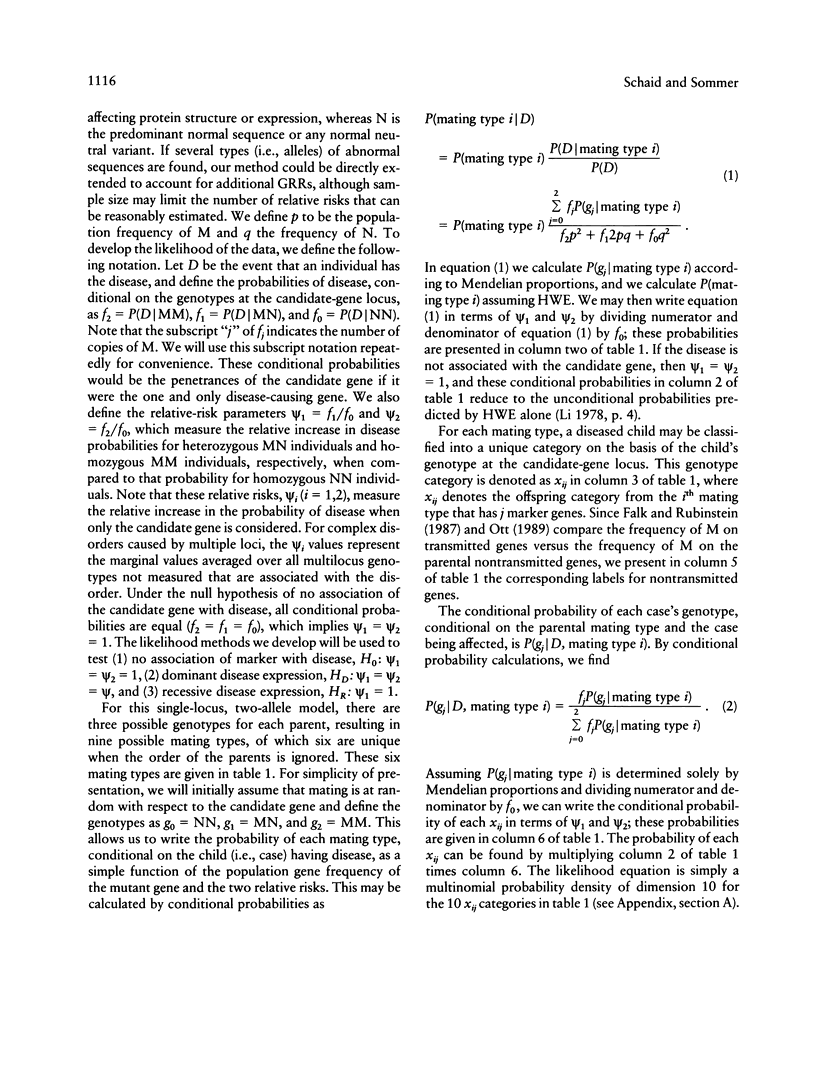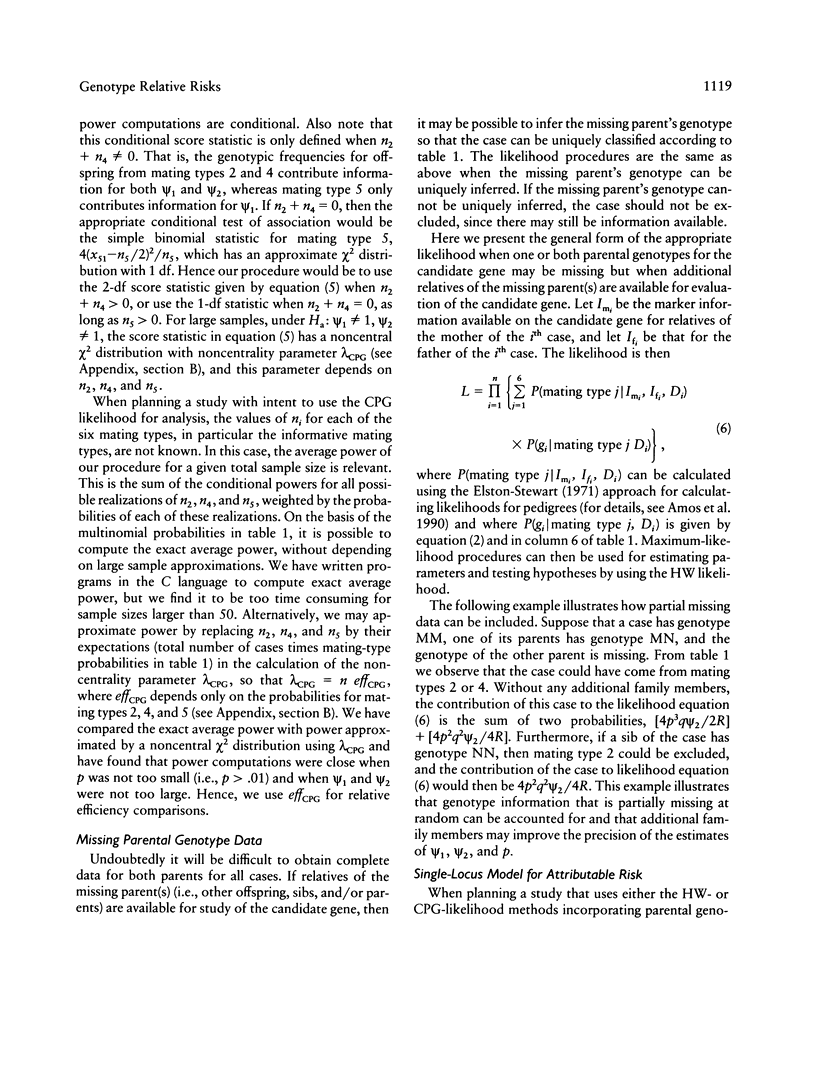Abstract
Design and analysis methods are presented for studying the association of a candidate gene with a disease by using parental data in place of nonrelated controls. This alternative design eliminates spurious differences in allele frequencies between cases and nonrelated controls resulting from different ethnic origins and population stratification for these two groups. We present analysis methods which are based on two genetic relative risks: (1) the relative risk of disease for homozygotes with two copies of the candidate gene versus homozygotes without the candidate gene and (2) the relative risk for heterozygotes with one copy of the candidate gene versus homozygotes without the candidate gene. In addition to estimating the magnitude of these relative risks, likelihood methods allow specific hypotheses to be tested, namely, a test for overall association of the candidate gene with disease, as well as specific genetic hypotheses, such as dominant or recessive inheritance. Two likelihood methods are presented: (1) a likelihood method appropriate when Hardy-Weinberg equilibrium holds and (2) a likelihood method in which we condition on parental genotype data when Hardy-Weinberg equilibrium does not hold. The results for the relative efficiency of these two methods suggest that the conditional approach may at times be preferable, even when equilibrium holds. Sample-size and power calculations are presented for a multitiered design. The purpose of tier 1 is to detect the presence of an abnormal sequence for a postulated candidate gene among a small group of cases. The purpose of tier 2 is to test for association of the abnormal variant with disease, such as by the likelihood methods presented. The purpose of tier 3 is to confirm positive results from tier 2. Results indicate that required sample sizes are smaller when expression of disease is recessive, rather than dominant, and that, for recessive disease and large relative risks, necessary sample sizes may be feasible, even if only a small percentage of the disease can be attributed to the candidate gene.
Full text
PDF












Selected References
These references are in PubMed. This may not be the complete list of references from this article.
- Amos C. I., Dawson D. V., Elston R. C. The probabilistic determination of identity-by-descent sharing for pairs of relatives from pedigrees. Am J Hum Genet. 1990 Nov;47(5):842–853. [PMC free article] [PubMed] [Google Scholar]
- Beaudet A., Bowcock A., Buchwald M., Cavalli-Sforza L., Farrall M., King M. C., Klinger K., Lalouel J. M., Lathrop G., Naylor S. Linkage of cystic fibrosis to two tightly linked DNA markers: joint report from a collaborative study. Am J Hum Genet. 1986 Dec;39(6):681–693. [PMC free article] [PubMed] [Google Scholar]
- Bodmer W. F., Bailey C. J., Bodmer J., Bussey H. J., Ellis A., Gorman P., Lucibello F. C., Murday V. A., Rider S. H., Scambler P. Localization of the gene for familial adenomatous polyposis on chromosome 5. Nature. 1987 Aug 13;328(6131):614–616. doi: 10.1038/328614a0. [DOI] [PubMed] [Google Scholar]
- Elston R. C., Stewart J. A general model for the genetic analysis of pedigree data. Hum Hered. 1971;21(6):523–542. doi: 10.1159/000152448. [DOI] [PubMed] [Google Scholar]
- Falk C. T., Rubinstein P. Haplotype relative risks: an easy reliable way to construct a proper control sample for risk calculations. Ann Hum Genet. 1987 Jul;51(Pt 3):227–233. doi: 10.1111/j.1469-1809.1987.tb00875.x. [DOI] [PubMed] [Google Scholar]
- Gusella J. F., Wexler N. S., Conneally P. M., Naylor S. L., Anderson M. A., Tanzi R. E., Watkins P. C., Ottina K., Wallace M. R., Sakaguchi A. Y. A polymorphic DNA marker genetically linked to Huntington's disease. Nature. 1983 Nov 17;306(5940):234–238. doi: 10.1038/306234a0. [DOI] [PubMed] [Google Scholar]
- Lathrop G. M. Estimating genotype relative risks. Tissue Antigens. 1983 Aug;22(2):160–166. doi: 10.1111/j.1399-0039.1983.tb01183.x. [DOI] [PubMed] [Google Scholar]
- Leppert M., Dobbs M., Scambler P., O'Connell P., Nakamura Y., Stauffer D., Woodward S., Burt R., Hughes J., Gardner E. The gene for familial polyposis coli maps to the long arm of chromosome 5. Science. 1987 Dec 4;238(4832):1411–1413. doi: 10.1126/science.3479843. [DOI] [PubMed] [Google Scholar]
- Risch N. Genetic linkage and complex diseases, with special reference to psychiatric disorders. Genet Epidemiol. 1990;7(1):3–45. doi: 10.1002/gepi.1370070103. [DOI] [PubMed] [Google Scholar]
- Sobell J. L., Heston L. L., Sommer S. S. Delineation of genetic predisposition to multifactorial disease: a general approach on the threshold of feasibility. Genomics. 1992 Jan;12(1):1–6. doi: 10.1016/0888-7543(92)90398-c. [DOI] [PubMed] [Google Scholar]
- Spielman R. S., McGinnis R. E., Ewens W. J. Transmission test for linkage disequilibrium: the insulin gene region and insulin-dependent diabetes mellitus (IDDM). Am J Hum Genet. 1993 Mar;52(3):506–516. [PMC free article] [PubMed] [Google Scholar]
- Terwilliger J. D., Ott J. A haplotype-based 'haplotype relative risk' approach to detecting allelic associations. Hum Hered. 1992;42(6):337–346. doi: 10.1159/000154096. [DOI] [PubMed] [Google Scholar]


